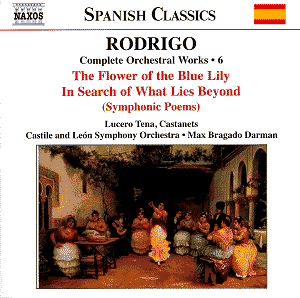As can be seen from the recording dates some
of this music was apparently put ‘in the can’ as long ago as 1990
… quite extraordinary. Naxos’s Spanish Classics series must therefore
have been ‘in the air’ for some time. Of course in 1990 Rodrigo
was alive, so I wonder if he heard some of these works, or attended
the recording sessions or approved. We are not told. But I see
no reason why he shouldn’t have done. These are mostly fine recordings
and excellent performances. Quite a few of them are in a nationalistic
light music category but two are profound and rare works of much
interest.
Like his compatriots, Jesus Guridi (1886-1961),
Jesus Arambarri (1902-1960), Rodrigo studied in Paris with Paul
Dukas. Joaquin Turina (1882-1949) was another who came under the
all-pervasive French influence of the 1920s and 1930s. All of
them were encouraged to write symphonic poems as Dukas and d’Indy
had and were doing. These pieces, difficult to programme today,
have mostly passed out of the repertoire. They between seven and
twenty minutes and take a nationalistic or parochial stance, often
with more meaning for the local cognoscenti than for Europe. Although
Rodrigo is practically a household name none of these works are
at all well known, outside Spain or even much in Spain.
The ‘Dos danzas espanolas’ is almost a castanet
concerto, so prominent is this typically Iberian instrument. At
just over nine minutes it is about as much as one can cope with
… but good fun. The ‘Tres viejos aires de danza’ is neo-classical
especially the delightful, if very lightweight Minuet. The Giga
brings to the short work a much-needed lively ending. ‘Palillos
y panderetas’ translates as ‘castanets and tambourines’. It opens
the CD. Contrary to its title it does not particularly feature
these two instruments. It is a brief and colourful three-movement
suite and includes a delightful ‘Pastoral’ over an ostinato rhythm.
It was commissioned by the mayor of Madrid and ended up being
the composer’s last orchestral work.
The two longest works are the most serious and
to me at least, present a side of the composer, which I had never
suspected.
‘Per la flor del Iliri blau’ translated in the
CD booklet as ‘For the flower of the blue lily’ is the only piece
of the disc which has a less than top standard recording. The
climaxes are quite boxy and constricted. At twenty minutes duration
however it deserves your attention. The story is from Valencian
Legend in which three sons of a dying king go in search of a blue
lily whose magic powers could save their father. The outcome is
successful but tragic, ideally captured by the composer. It dates
from 1934. Over forty years later the blind composer, now well
into his 70s, was still prepared to find inspiration in the extra-musical.
This much is evident from his Houston commission ‘A la busca del
mas allai’ (In search of way lies beyond). There is no trace of
‘Spanishry’ here but a work of totally international appeal. It
opens with a rising drum roll and a questioning tri-tone. It is
almost keyless at times. These two works are coupled on another
disc incidentally conducted by Batiz (EMI 767435-2), which I have
not heard and cannot comment on.
The CD booklet notes written by Enrique Martinez
Miura are quite good on Rodrigo’s biography, which is not entirely
necessary, but disappointing on the music. This is a pity as these
pieces are so little known. As is now increasingly common there
are extensive notes on the performers … even the solo castanets
player, the indomitable Lucero Tena. The Castile and Leon orchestra
under Spanish maestro Max Bragado Darman (he it is who at the
time of recording was the artistic director of this newly founded
orchestra) are in fine form.
Gary Higginson
